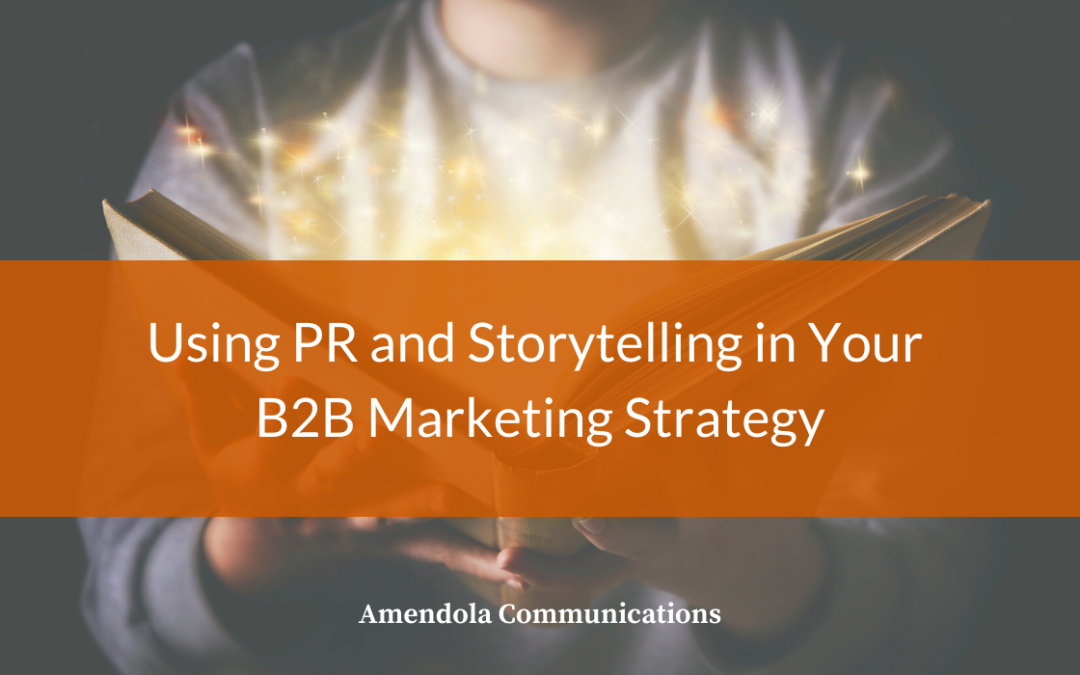
by admin | Mar 11, 2020 | Blog
Your company has a story and people want to hear it.
Remember the last time you heard a great story? If you’re anything like me, it was probably a movie or T.V. show. Since the entertainment industry makes money by telling good stories, this makes sense. But in our fast-paced, tech-driven society, we rely on text messaging (guilty!), email and IMs and we don’t take the time to tell stories like we used to.
In the Don Draper, Mad Men, days of advertising storytelling was relatively simple. Come up with a catchy phrase and call it day. Now that we are bombarded with marketing campaigns on a 24×7 basis, it is harder to cut through the clutter.
That’s where storytelling and public relations come in. But what does it take to tell a really good story? Especially in a B2B environment?
Not too long ago, I was asked by my marketing team to think about a B2B brand that really made an impression on me. Of course, my first reaction was come on. B2B + engaging content = doesn’t add up!
But then I thought about it and remembered a simple phrase that a sales representative from Wrike told me, “what you need is a single source of truth.”
If you aren’t familiar with Wrike, it’s a project management platform that can be shared across teams and business. It really can be that one source of truth rather than combing through endless emails to find that one URL or status update that you might have accidentally deleted because you tried to check your work email on your phone while at happy hour (I’ve only heard via storytelling that these things can happen!).
That phrase single source of truth will never leave my brain. Because it is precisely what my brain needed to hear to solve my need for organizing information.
Now I am an unofficial brand ambassador for this company. And that is the power of knowing your brand’s story.
At the end of the day, your story shouldn’t be about you at all. It should be about the things that matter to your buyer personas, but it should also be personal. (Yes, even B2B can be personal; we’re still humans in the work environment).
Never underestimate the value of making an emotional connection in the B2B world especially in healthcare. With health IT becoming more and more saturated, the B2B landscape is changing and it’s becoming more critical for strong B2B brands to do what strong brands do around the world engender trust and reduce perceived risk.
We have critical problems to fix in healthcare and every single client I work with creates technology that betters the lives of so many patients, physicians, nurses, payers the list could go on for days. But sometimes getting to the root of how this technology is shifting the healthcare environment is challenging.
Successful public relations activities rely on being able to tell powerful and insightful stories. Storytelling is an important aspect to public relations strategies because it allows companies to better connect with their audience.
Here are four ways your B2B brand can become a good storyteller.
1. Start with a broad narrative that helps tell the story of your company.
Purpose is essential to a strong corporate culture and it is often activated and reinforced through narrative. Individuals must learn to connect their drives to the organization’s purpose and to articulate their story to others.
A professor at Harvard University developed a simple framework for those hoping to develop a narrative approach to their purpose-driven organizations: “Self, Us, Now.” “Self” looks at the real-life events of the leader or leaders that created a company it helps to establish the values that will ultimately become the values of the organization.
“Us” aims to connect those values with broader shared values of your audiences or stakeholders, e.g., clients or employees. By weaving these personal narratives into the narratives of others, you create a common narrative for the group or organization.
And finally, “now” is the urgent call to action for those who wish to achieve the same purpose as your organization.
2. Consolidate your narrative into an elevator pitch.
Now that you’ve develop what I like to call the soul of your company, it’s likely a lengthy narrative as it should be since your company is solving some of healthcare’s most complex challenges. The elevator should pull out some of those key emotion-grabbing narratives and concisely explain:
- Who are you?
- What do you offer?
- What problem do you solve?
- How are you different (unique selling proposition)?
- Your call to action
3. Adapt your elevator pitch into something that could be used as an “About Us.”
Now that you have a well-developed narrative that explains your unique identity, craft your story! Evoke an emotional response in your buyer persona. Provide a simple and clear value proposition, establish your credibility, and give a call to action. As they say, the best way to sell something is to not sell anything. Earn trust and loyalty by telling a compelling story to help stick in your customer’s mind.
4. Frame up your narrative against core themes that can represent your overall business.
Likely you’ve got a lot of products but talking about each product separately can quickly become overwhelming. If it’s overwhelming for your marketing team, then it is overwhelming for your customers too. Work to identify the core themes that your products can be categorized into. Then tell how those themes are solving our most critical problems.
Storytelling can’t be mastered overnight. It takes practice but it is worth it as there is nothing more powerful than making your content and news relatable to your audience. Tell good tales, and you’ll quickly find your audience will see you as a true thought leader and they will come to you.

by Marcia Rhodes | May 30, 2018 | Blog
When it comes to HIMSS Global Conference speaker proposals, Amendola Communications enjoys a 75% win rate. That means that out of 12 speaking abstracts we write and submit on behalf of our clients, nine are accepted.
Quite impressive considering that HIMSS has a less than 30% acceptance rate. In fact, for HIMSS18, 742 proposals were received and only 224 were accepted, which means 518 were declined.
The process is not easy and takes anywhere from 12-16 hours per proposal. If only clients would invest the same time and energy in preparing their presentations! If clients were willing to carve out time for presentation training or coaching before they get up on the stage, here is what I would suggest.
Grab attention. High tech need not be dry tech. Instead of diving right into your presentation, open with a bang with one or more of the following:
- Startling statistic or statement
- Rhetorical question
- Historical analogy or example
- Quotation
- Personal anecdote
- Something specific to your audience
- Something to make audience feel good about themselves
- Promise
- Meme
- Short story (see example below)
- Headline from today’s newspaper (show newspaper)
For this last one, I am quoted in the book Presentations for Dummies (as Marcia Lemmons, my former married name) sharing this very tip. I first saw it used by a business development director at Accenture where I worked in the 90’s. The biz dev director would begin his presentation by holding up a fresh copy of USA Today or the Wall Street Journal. He would point to a headline and find a clever way to tie it to his presentation. This had the effect of making his presentation more current, relevant and way more interesting.
Short stories can be impactful if you can deliver them in 30 seconds or less. I saw this technique used very effectively by a Six Sigma Master Black Belt who would tell “The Dolphin Story” to open a workshop on the Voice of the Customer. It went like this:
“During World War II a mythology developed that dolphins love people. It was a myth propagated by sailors who dolphins rescued from drowning by pushing them ashore. A crew decided to set up camp on a ship to observe this first hand. After a few weeks on the ship, they concluded: dolphins don’t love people”¦they like to push things”¦the problem is we never hear from the people they push back into sea.”
State the problem or need. Why should the audience care? Spend one to two minutes sharing evidence, data, news reports or personal experience to illustrate the problem or opportunity. Stating the challenge up-front makes the audience uncomfortable enough that they will want to stay to hear your solution. This is referred to as the “tension-relief” technique used by playwrights.
Establish a pattern. Tell the audience what to expect from you in the next hour. Provide a roadmap agenda so they can more easily follow along.
Presentation patterns can be in the form of:
- Lists
- Chronological order
- Physical location (ex: Europe, Asia, N. America)
- Extended metaphor
- Divide a word
- Before/after
- Theory/practice
- Why/how/what
- Provider/payer/pharma
- Classic story (three acts)
Share the solution. This is the guts of your presentation; the knowledge or expertise you have been asked to share. Tip: When creating your presentation, you can get a jumpstart by working on this section first then working on your intro, extro and other slides later. You will find your creativity will kick in once you feel confident in what you have to say and can easily build on top of it.
Finish strong! Remind your audience of what they’ve just heard. In this section you can underscore the problem or remind them of what’s worth remembering. What are they supposed to do or change? Tie your closing statements to your opening grabber so the presentation feels whole and complete; you’ve come full circle. Give a clear signal that “We’re done.”
Rethink Q&A
Many presenters make the mistake of ending their presentation with the audience Q&A. They take questions from the audience and provide answers that they may not have had a chance to prepare for. This is also the section where it is easy for a speaker to lose control of the room. We recommend taking no more than six questions before bringing your presentation to a proper close with a few choice statements. You might even ask and answer your own question at the very end. For example, “One question CIOs almost always ask me is”¦.” Then provide your well thought-out answer.
Making it work
As a society, we don’t just want to be informed. We want to be entertained too. Just look at the news today compared to 30 years ago. As they say, “Educate the best, entertain the rest.”
The same holds true for presentations. The more lively and engaging you make it, the more your audience will be interested in what you have to say. Think through the structure, grab their interest from the beginning, and give them valuable insights they didn’t know before and you’ll keep your audience riveted. Then sit back and enjoy the applause.
And if you need a little help, give us a call!

by Matt Schlossberg | Nov 8, 2017 | Blog
“Marketing is no longer about the stuff that you make, but the stories you tell.”
Seth Godin
Roaming the Exhibit Hall at HIMSS17 last year, I found a truly unique healthcare solution. It solves seemingly intractable problems with uncommon grace and simplicity. It’s intuitive, innovative and disruptive. I predict that it will ascend the rarefied summit of “Revolutionizing How Healthcare Happens.”
What was this paradigm-shifting solution and what was the visionary company behind it?
All of them. All 1,323 exhibitors at the conference.
OK, maybe a few expressed a bit more modesty. But with varying degrees of word choice and hyperbolic intensity, most used this highly subjective template to describe their solutions. Their baby is the most beautiful in the world just accept it.
But words that once felt so tantalizing and full of possibility have become eye-glazing clichs. Worse, they are beginning to subsume good storytelling, like a lush and varied landscape overrun by kudzu.

We’re being “disruptive’ over here!
We live in an age of multi-media communication. We can slice-and-dice any demographic, curate content a million different ways, and measure it all more precisely than ever before. But somewhere along the way, many of us have forgotten how to tell a story and tell it well.
Healthcare is full of terrific and, yes, innovative solutions. However, the signal you believe you are projecting into the marketplace with slick marketing and flashy buzzwords is just another forgettable layer of noise. Old-fashioned storytelling, on the other hand, is a method that more readily sticks in the minds of editors and customers.
Lions and Gazelles
The journalism profession is shrinking and de-centralizing. The newspapers and magazines that aren’t shuttering are dramatically reducing staff and tightening the purse strings. Healthcare journalism is no exception.
Here’s an example. The HIMSS Annual Conference is the largest health IT tradeshow in North America. For many healthcare professionals, this show sets the agenda for the rest of the year. In 2015, 126 editors registered for the Conference one for every 10 exhibitors.
In 2017, only 76 editors registered one for every 17 exhibitors. And a number of those “editors” were actually in sales, seeking ad and sponsorship dollars. Plus, these editors aren’t just roaming the Exhibit Hall. They’re also interviewing keynote speakers, attending education sessions, hosting their own meetings and trying to jam it all into four days.
Think of it this way: Your healthcare company is one of 1,300 lions chasing at best 60 gazelles. A lot of you are going to go hungry.

“But our platform is scalable across the enterprise”
This is not to say that your solution is not revolutionary. It’s probably great! Terrific but guess what? Everyone else is saying the exact same thing about their solutions. Trust me, as a former healthcare reporter and editor, buzzwords were pure white noise. If you want to bag earned media in a shrinking media landscape, you need to up your game. You need to tell me a story.
Ideas Over Solutions
It would be easy enough to blast out yet another listicle of stuff you need to tell a good story. Here are 344 million of them via Google.
I would rather tell you how much I hated science as a kid.
A teacher in a too-short clip-on tie would blandly recite an endless list of equations, scientific jargon and theories until the bell rang for recess. I was temporarily free from the deadly boring grasp of arcane measurements cooked up by a bunch of Europeans who have been dead for 500 years.
None of what I was taught was wrong. It just didn’t mean anything to me.
Around that time, PBS aired Cosmos: A Personal Voyage. It was written and narrated by Carl Sagan, the famous science popularizer.
Sagan discussed all the same equations and theories and dead scientists as my teacher did. Some of it I understood, some of it I didn’t. But the difference was how all those facts connected to tell a 14-billion-year-old story. I was able to understand how all those discoveries impacted the world I lived in. Suddenly, the universe wasn’t a C+ on a future pop quiz. It was impossibly big and beautiful, brimming with weird worlds and strange physics. It was vast and violent and without mercy. And I was a part of it!
I don’t remember the name of my science teacher, but I remember Carl Sagan and the story he told in Cosmos.
All those capabilities and features of your healthcare solution what deeper story do they tell? How do they impact the lives of the people who will use them? How does it add to the larger healthcare stories being told today?
It’s not enough to say you’re innovative. People don’t connect to “innovative.” They connect to stories.
Your story might be big. It might be small. But if it’s meaningful, if it connects, it will find an audience. Tell a great story and your solution will rise above the noise.




